
The Plants The Cherokees Used For Pain Relief
The Cherokee people were originally located in the South Eastern United States, in parts of Alabama, Georgia, Tennessee, and North Carolina. The Cherokee Nation also refer to themselves as “Aniyvwiya” meaning the “Real People”, or the “Anigaduwagi” or the Kituwah people. The Cherokee Nation was forced to relocate to the Indian Territory (present-day Oklahoma) in 1838 after gold was discovered in their homelands.
The Cherokee Nation’s uses for natural medicines are something we all should learn from. Many of these Native remedies were the basis for the modern medicines that are commonly used today, such as penicillin. Here are 8 of their remedies that could help you treat your pain.
8 Plants Used For Pain Relief
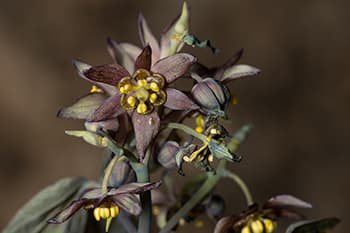 Blue cohosh (Caulophyllum thalictroides) is generally taken as a tincture. The Cherokee people used it during childbirth to ease pain and speed up labor. It can also be used to treat constipation, stomach cramps, hiccups, and induce menstruation. Blue Cohosh is a spreading and bushy plant when mature. Three leaves with lobed leaflets are purplish in spring. Inconspicuous, purplish-brown to yellow-green flowers in a loosely branched cluster.
Blue cohosh (Caulophyllum thalictroides) is generally taken as a tincture. The Cherokee people used it during childbirth to ease pain and speed up labor. It can also be used to treat constipation, stomach cramps, hiccups, and induce menstruation. Blue Cohosh is a spreading and bushy plant when mature. Three leaves with lobed leaflets are purplish in spring. Inconspicuous, purplish-brown to yellow-green flowers in a loosely branched cluster.
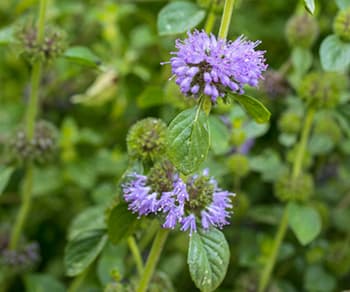 Pennyroyal (Mentha pulegium) is still used today in modern medicine. The uses of pennyroyal are vast. Pennyroyal is used to treat headaches, digestive pain, control muscle spasms, and even as a bug repellent. Pennyroyal is an annual mint with small, oval leaves arranged opposite each other on a square-like stem. Leaves are full and may be sparsely toothed or smooth on the margins. The tiny blue-violet flowers grow from the leaf axils on the top portion of the stems.
Pennyroyal (Mentha pulegium) is still used today in modern medicine. The uses of pennyroyal are vast. Pennyroyal is used to treat headaches, digestive pain, control muscle spasms, and even as a bug repellent. Pennyroyal is an annual mint with small, oval leaves arranged opposite each other on a square-like stem. Leaves are full and may be sparsely toothed or smooth on the margins. The tiny blue-violet flowers grow from the leaf axils on the top portion of the stems.
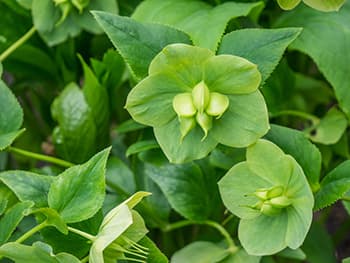 Green Hellebore (Helleborus viridis) is mainly used today for insecticides. The bulb and root are used to make medicine. The Cherokee people use it to treat body pain but many native groups believed it was a cure-all. The plant’s leaves are smooth initially and turn leathery later. The palmate or pedate leaves are deeply cut, often with a serrated or dentate edge. All species have tripartite leaves, with leaflets that are also divided. The flower has a greenish hue, with petaloid sepals.
Green Hellebore (Helleborus viridis) is mainly used today for insecticides. The bulb and root are used to make medicine. The Cherokee people use it to treat body pain but many native groups believed it was a cure-all. The plant’s leaves are smooth initially and turn leathery later. The palmate or pedate leaves are deeply cut, often with a serrated or dentate edge. All species have tripartite leaves, with leaflets that are also divided. The flower has a greenish hue, with petaloid sepals.
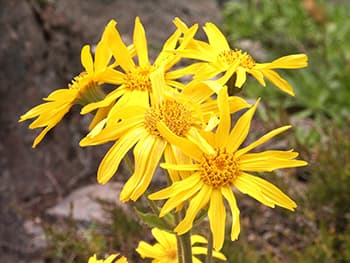 Arnica (Arnica montana) is a beautiful yellow flower used by many Native people. The petals are usually used as a tea to treat general pain and inflammation. Arnica produces yellow-orange, daisy-like blooms in late spring and early summer and the leaves are bright green. The upper leaves are toothed and slightly hairy, while the lower leaves have rounded tips.
Arnica (Arnica montana) is a beautiful yellow flower used by many Native people. The petals are usually used as a tea to treat general pain and inflammation. Arnica produces yellow-orange, daisy-like blooms in late spring and early summer and the leaves are bright green. The upper leaves are toothed and slightly hairy, while the lower leaves have rounded tips.
⇒ When Painkillers Won’t be Available, Try This (Video)
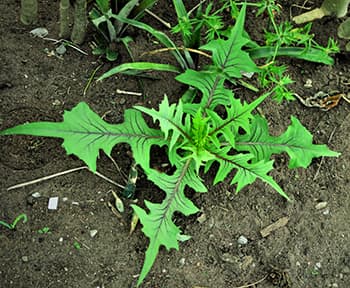 Canada lettuce (Lactuca canadensis) is a species of wild lettuce known by its common name. Lactucarium has the effects of a feeble opium, but without its tendency to cause digestive upsets or addiction. It’s used in modern medication to treat whooping cough, asthma, urinary tract problems, cough, insomnia, restlessness, excitability in children, and painful menstrual periods. Canada lettuce can grow in stalks. The leaves vary considerably, from entire to toothed, to pinnately divided, and have a narrow unstalked base or a clasping base. When the stem or leaves are broken they excrete a milky liquid. Its blossom resembles dandelion flowers.
Canada lettuce (Lactuca canadensis) is a species of wild lettuce known by its common name. Lactucarium has the effects of a feeble opium, but without its tendency to cause digestive upsets or addiction. It’s used in modern medication to treat whooping cough, asthma, urinary tract problems, cough, insomnia, restlessness, excitability in children, and painful menstrual periods. Canada lettuce can grow in stalks. The leaves vary considerably, from entire to toothed, to pinnately divided, and have a narrow unstalked base or a clasping base. When the stem or leaves are broken they excrete a milky liquid. Its blossom resembles dandelion flowers.
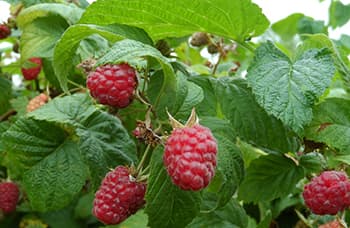 Red raspberry leaf (Rubus idaeus) is an herb most commonly used during labor to improve the effectiveness of the uterus. In addition, it may alleviate pain associated with labor. Cherokee people also used red raspberry in many ritual practices. Many still use red raspberry leaves to induce labor. Red raspberries are light-green leafed bushes with stems that have spade-shaped leaves that are toothed along the edges.
Red raspberry leaf (Rubus idaeus) is an herb most commonly used during labor to improve the effectiveness of the uterus. In addition, it may alleviate pain associated with labor. Cherokee people also used red raspberry in many ritual practices. Many still use red raspberry leaves to induce labor. Red raspberries are light-green leafed bushes with stems that have spade-shaped leaves that are toothed along the edges.
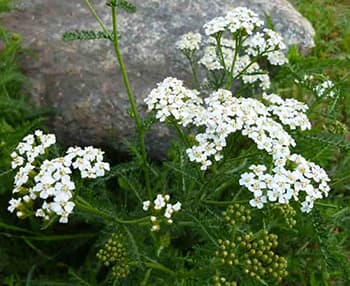 Yarrow (Achillea millefolium) was also used by the Cherokees for multiple ailments. Yarrow is used for fever, common cold, hay fever, absence of menstruation, dysentery, diarrhea, loss of appetite, gastrointestinal tract discomfort, and to induce sweating. Some people chew the fresh leaves to relieve a toothache. Wild yarrow typically has white or rarely pink flowers, but cultivated yarrow can have yellow, orange, pink, or red flowers. Yarrow stems are grooved and have small wooly hairs.
Yarrow (Achillea millefolium) was also used by the Cherokees for multiple ailments. Yarrow is used for fever, common cold, hay fever, absence of menstruation, dysentery, diarrhea, loss of appetite, gastrointestinal tract discomfort, and to induce sweating. Some people chew the fresh leaves to relieve a toothache. Wild yarrow typically has white or rarely pink flowers, but cultivated yarrow can have yellow, orange, pink, or red flowers. Yarrow stems are grooved and have small wooly hairs.
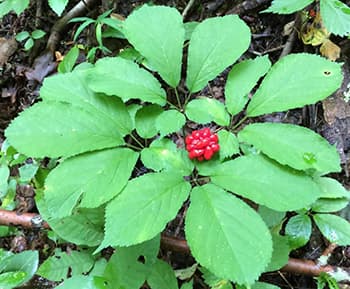 American Ginseng (Panax quinquefolius) was a great medicine for the Cherokees. They made tea from the roots to treat headaches and cramps. The tea was also used to stimulate appetite in the elderly, or for those who had the flu, a cold, or infections. One way the Cherokees prepared this plant was to chew the roots and blow the material through a wooden tube onto a painful area of the body. The ginseng plant has a single stem that ends with a whorl of 1 to 4 leaves. Each leaf usually has anywhere from 3 to 5 leaflets. If the plant is mature, you will see a group of 6 to 20 whitish-green flowers. Once the plant fruits, those flowers become tiny red Ginseng berries.
American Ginseng (Panax quinquefolius) was a great medicine for the Cherokees. They made tea from the roots to treat headaches and cramps. The tea was also used to stimulate appetite in the elderly, or for those who had the flu, a cold, or infections. One way the Cherokees prepared this plant was to chew the roots and blow the material through a wooden tube onto a painful area of the body. The ginseng plant has a single stem that ends with a whorl of 1 to 4 leaves. Each leaf usually has anywhere from 3 to 5 leaflets. If the plant is mature, you will see a group of 6 to 20 whitish-green flowers. Once the plant fruits, those flowers become tiny red Ginseng berries.
“Didanawisgi” is the Cherokee word for medicine man. The concept through all Native American remedies is the idea of wellness when the whole body and mind are one. The Cherokee word “tohi” – health – is the same as the word for peace. You’re in good health when your body is at peace. We can all agree that when our body isn’t feeling well, our mental state suffers, and when our mind isn’t feeling well, our body suffers as well.
We have so much to learn from the Native people of the United States. Many of their lessons were lost due to the colonization of America. Native people made sure to pass down as many of their teachings and culture, despite everything that has happened to their people due to colonization. We are so lucky that these teachings were not forgotten. Many of the herbs and plants they used for medicine are still used today in medication and supplements.
You may also like:
 5 ‘Miracle Trees’ The Native Americans Used For Medicine
5 ‘Miracle Trees’ The Native Americans Used For Medicine
10 Things to Plant in The Fall and Harvest in The Dead of Winter (Video)

Some of you articles all you to download them in PDF format to read at your liesure? Why not this one and the rest?
I was able to download this article. Just touch the 3 dots up top right side then the download arrow. Hope this helps
Click on the Green Thumb nail with the W on it to save it to your computer
What about lobelia?
Hello Joe,
Thank you for your interest in our articles! They can be saved as a PDF by clicking the Pdf button at the end of each article.
If you still encounter any issues whatsoever, please let us know by sending an email with more details regarding the error.
Many blessings and good health!
just above the word Comments
do you cook the red raspberry leaves, eat them raw, or make them into tea?
Hello Debee,
The most common way to consume Red Raspberry Leaf is as a tea, which is very simple to prepare. Simply steep 1 teaspoon to 2 tablespoons of dried herb in 1 cup of water for 10-15 minutes. You can also add a little bit of honey for sweetness.
Many blessings and good health!
Can you please list your sources?